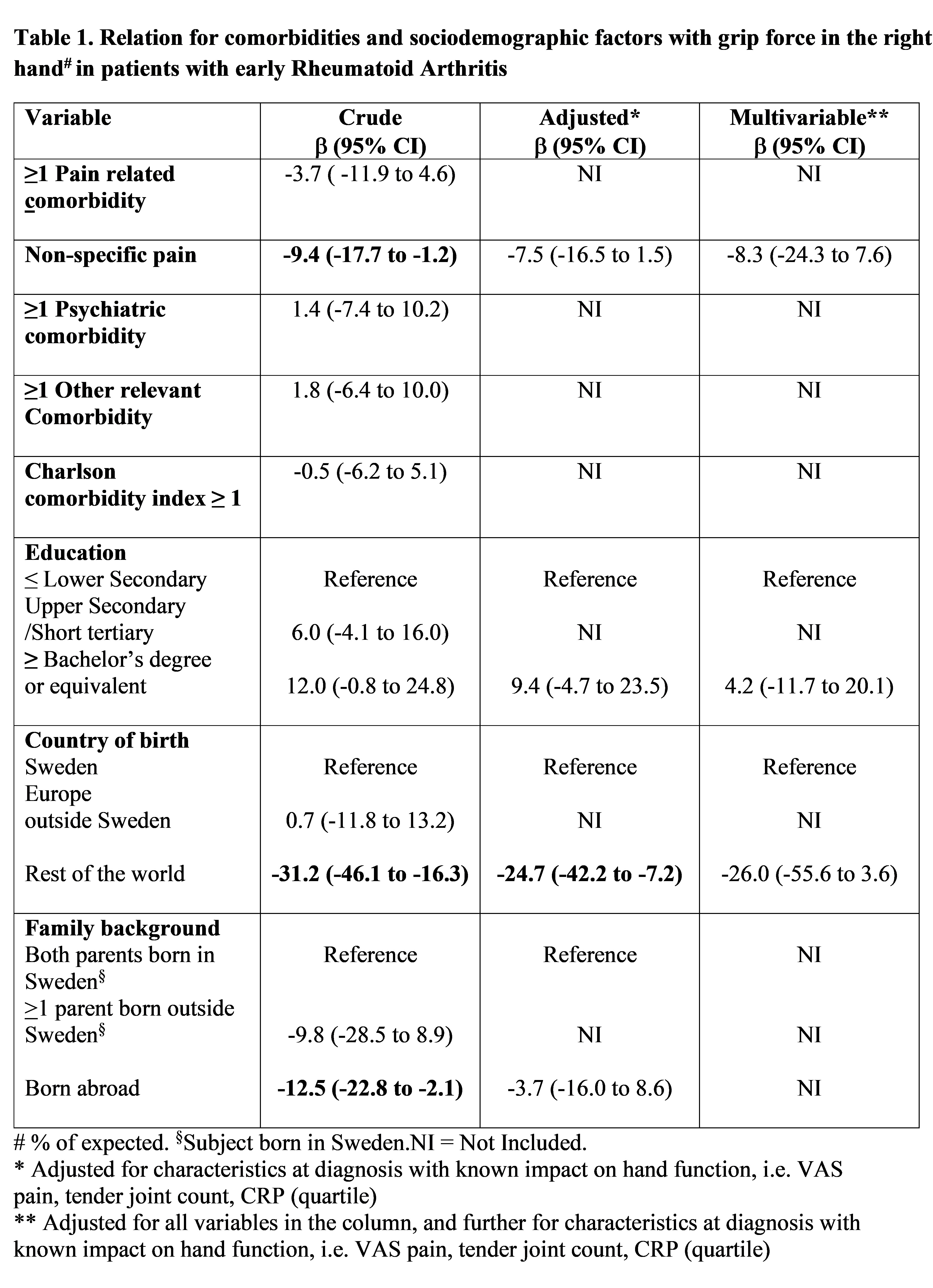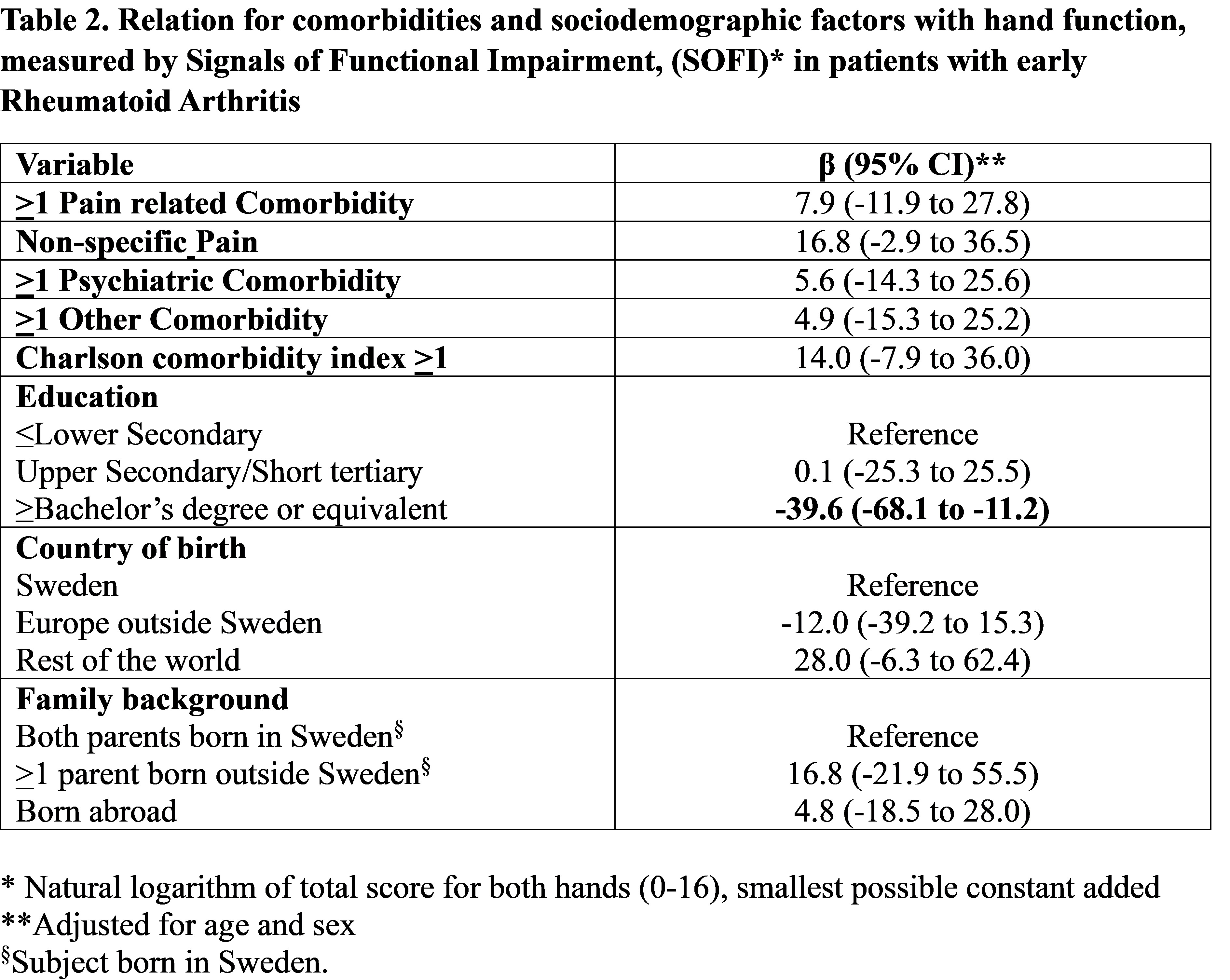Session Information
Session Type: Poster Session C
Session Time: 10:30AM-12:30PM
Background/Purpose: Rheumatoid arthritis (RA) is characterized by polyarticular involvement of the hands, leading to impaired function. The impact of active inflammation on disability in early RA is influenced by age and sex of the patient, but other individual factors may also play a role. The purpose of this study was to examine the relation for comorbidities and sociodemographic factors with measures of hand function in patients with early RA.
Methods: In a retrospective study, consecutive patients diagnosed with RA and a reported symptom duration of < 12 months at a single rheumatology center in 2012-2016 were included. All patients fulfilled the 2010 ACR/EULAR and/or the 1987 ACR classification criteria for RA. Patients were assessed and followed according to current clinical practice, including structured examination by occupational therapists for most patients. Average grip force values of the right hand were evaluated and expressed as % of expected values, based on age- and sex-specific reference values. At the same visit, hand function was also assessed using the Signals of Functional Impairment test (SOFI, total score for both hands 0-16, higher values indicating worse function). Data on comorbidities were retrieved from a regional healthcare register, and information on level of formal education, country of birth and family background was obtained from national population registers. Prevalent comorbidities were defined based on diagnostic codes registered prior to diagnosis of RA. The relations for comorbidities and sociodemographic factors with the first available values for grip force and total SOFI score for hands were assessed using linear regression models. For the age-sex adjusted models including SOFI, the dependent variable was logarithmically transformed because of non-normal distribution of residuals.
Results: In a total of 367 included patients with early RA, grip force had been measured in 289 cases (75 % females, mean age at diagnosis 58.4 years, 68% ACPA positive). The median time from diagnosis to assessment of grip force and SOFI was 1.7 months. The mean grip force was 50.1 % of expected. The median SOFI total score for hands was 1 (interquartile range 0-3; n=277).
Patients born outside Europe had a significantly lower grip force. Estimates were similar in multi-adjusted models, including a prior diagnosis of non-specific pain, level of education and measures of disease activity at diagnosis (Table 1).
Higher education (bachelor’s degree or equivalent) was associated with a better hand function, assessed by SOFI (Table 2). This association reached statistical significance in multivariable analysis (b -0.31; 95% CI -0.60 to -0.03, adjusted for age, sex, tender joint count and quartile of CRP).
Conclusion: Sociodemographic factors are associated with measures of hand function. Differences in grip force by country of birth may be related to ethnic factors affecting muscle strength, cultural aspects or language related difficulties with test instructions. A high level of education may reduce the impact of RA on complex hand mobility. These patterns were not explained by differences in baseline disease activity or in prevalent comorbidities.
To cite this abstract in AMA style:
Rydholm M, Hameed M, Eberhard A, Sharma A, Cagnotto G, Turesson C. Relation Between Sociodemographic Factors and Hand Function in Patients with Early Rheumatoid Arthritis [abstract]. Arthritis Rheumatol. 2024; 76 (suppl 9). https://acrabstracts.org/abstract/relation-between-sociodemographic-factors-and-hand-function-in-patients-with-early-rheumatoid-arthritis/. Accessed .« Back to ACR Convergence 2024
ACR Meeting Abstracts - https://acrabstracts.org/abstract/relation-between-sociodemographic-factors-and-hand-function-in-patients-with-early-rheumatoid-arthritis/


